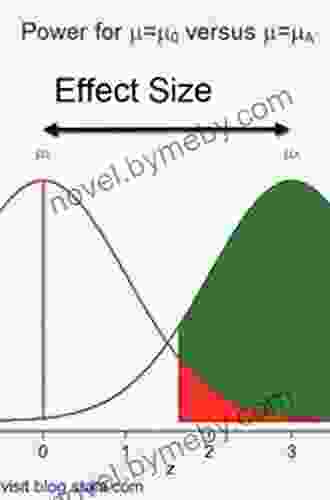Determining Sample Size and Power in Research Studies: A Comprehensive Guide

In research studies, determining the appropriate sample size and statistical power is crucial for obtaining accurate and meaningful results. A properly selected sample size ensures that the research findings are representative of the population under investigation, while statistical power indicates the likelihood of detecting a significant effect if it exists.
4.2 out of 5
| Language | : | English |
| File size | : | 8391 KB |
| Screen Reader | : | Supported |
| Print length | : | 140 pages |
This comprehensive guide will provide a step-by-step approach to determining sample size and statistical power. We will explore the key concepts, statistical formulas, and practical considerations to help researchers make informed decisions.
Step 1: Define the Research Question and Hypothesis
The first step is to clearly define the research question and hypothesis. The research question identifies the specific aspect of the population that the study seeks to investigate. The hypothesis, on the other hand, is a testable statement about the relationship between variables.
For example, a research question could be: "Does a new educational intervention improve student learning outcomes?" The corresponding hypothesis could be: "The new educational intervention will result in higher student learning outcomes compared to the traditional method." Clearly defining the research question and hypothesis will help determine the appropriate sample size and statistical power.
Step 2: Estimate the Effect Size
The effect size is a measure of the magnitude of the anticipated effect that the independent variable will have on the dependent variable. It represents the expected difference between the experimental and control groups.
There are various methods for estimating the effect size, including:
- Literature review: Consult previous studies that have investigated similar research questions.
- Pilot study: Conduct a small-scale study to gather preliminary data and estimate the effect size.
- Expert opinion: Seek advice from experts in the field who have knowledge of the research topic.
Step 3: Choose the Statistical Test
The choice of statistical test depends on the research design, the type of data collected, and the research question. Some common statistical tests include:
- t-test: Used to compare the means of two independent groups.
- ANOVA: Used to compare the means of three or more independent groups.
- Regression analysis: Used to model the relationship between a dependent variable and one or more independent variables.
Step 4: Calculate the Sample Size
The sample size is the number of participants required to achieve a desired level of statistical power. The formula for calculating the sample size depends on the statistical test, the effect size, the desired level of statistical power, and the alpha level (the probability of rejecting the null hypothesis when it is true).
There are numerous online calculators and statistical software packages that can assist with sample size calculations. It is important to consider the practical feasibility of recruiting and managing a sample of the calculated size.
Step 5: Determine Statistical Power
Statistical power is the probability of detecting a significant effect if it truly exists. It is an important measure of the sensitivity of the study to detect differences between groups.
The formula for calculating statistical power depends on the sample size, the effect size, and the alpha level. By setting a desired level of statistical power, researchers can determine the minimum sample size required to achieve it.
Practical Considerations
In addition to the technical aspects of determining sample size and power, several practical considerations should be taken into account:
- Cost: Recruiting and managing a large sample can be expensive. Researchers need to balance the desired power with budget constraints.
- Time: Conducting a study with a large sample can be time-consuming. Researchers should plan for adequate time to recruit participants and collect data.
- Response rate: When using surveys or questionnaires, it is important to anticipate a lower response rate than the calculated sample size. Researchers may need to adjust the sample size accordingly.
Determining sample size and power is a critical step in the design of any research study. By following the steps outlined in this guide, researchers can ensure that their studies have sufficient power to detect meaningful effects and obtain accurate and informative results.
It is important to note that sample size and power calculations are estimates, and the actual results may vary. Researchers should conduct sensitivity analyses to determine how changes in the effect size or sample size impact the statistical power.
By carefully considering the concepts and methods presented in this guide, researchers can make informed decisions about the sample size and statistical power of their research studies, ultimately leading to more rigorous and reliable findings.
4.2 out of 5
| Language | : | English |
| File size | : | 8391 KB |
| Screen Reader | : | Supported |
| Print length | : | 140 pages |
Do you want to contribute by writing guest posts on this blog?
Please contact us and send us a resume of previous articles that you have written.
 Book
Book Novel
Novel Page
Page Chapter
Chapter Text
Text Story
Story Genre
Genre Reader
Reader Library
Library Paperback
Paperback E-book
E-book Magazine
Magazine Newspaper
Newspaper Paragraph
Paragraph Sentence
Sentence Bookmark
Bookmark Shelf
Shelf Glossary
Glossary Bibliography
Bibliography Foreword
Foreword Preface
Preface Synopsis
Synopsis Annotation
Annotation Footnote
Footnote Manuscript
Manuscript Scroll
Scroll Codex
Codex Tome
Tome Bestseller
Bestseller Classics
Classics Library card
Library card Narrative
Narrative Biography
Biography Autobiography
Autobiography Memoir
Memoir Reference
Reference Encyclopedia
Encyclopedia Rick Bass
Rick Bass Suzanne Swedo
Suzanne Swedo Teresa Mccallum
Teresa Mccallum Pleasant Despain
Pleasant Despain R S Penney
R S Penney Robin Karr Morse
Robin Karr Morse Sara Lyon
Sara Lyon Tim Maudlin
Tim Maudlin Riki Roash
Riki Roash Tracy Newman
Tracy Newman Syundei
Syundei Roger E Axtell
Roger E Axtell Rafi Chagani
Rafi Chagani Richard Wentworth
Richard Wentworth Ray Dalio
Ray Dalio Sarah Gristwood
Sarah Gristwood Richard Troeger
Richard Troeger Tim Swanwick
Tim Swanwick Tahir Shah
Tahir Shah Rose Davidson
Rose Davidson
Light bulbAdvertise smarter! Our strategic ad space ensures maximum exposure. Reserve your spot today!

 Eliot FosterThe Rise and Fall of German Economic Power: Insights from the 19th and 20th...
Eliot FosterThe Rise and Fall of German Economic Power: Insights from the 19th and 20th...
 Jessie CoxMastering Difficult Conversations: A Guide to Navigating Workplace Challenges...
Jessie CoxMastering Difficult Conversations: A Guide to Navigating Workplace Challenges... Roland HayesFollow ·4.3k
Roland HayesFollow ·4.3k Michael ChabonFollow ·5.3k
Michael ChabonFollow ·5.3k Anton FosterFollow ·11k
Anton FosterFollow ·11k John ParkerFollow ·5.4k
John ParkerFollow ·5.4k Eric NelsonFollow ·10.5k
Eric NelsonFollow ·10.5k Darrell PowellFollow ·9.8k
Darrell PowellFollow ·9.8k George R.R. MartinFollow ·11.5k
George R.R. MartinFollow ·11.5k Donovan CarterFollow ·2.4k
Donovan CarterFollow ·2.4k

 Mike Hayes
Mike HayesArthur Meighen: A Life in Politics
Arthur Meighen was one of Canada's most...

 Bryan Gray
Bryan GrayVindicated: Atlanta's Finest
In the heart of Atlanta, a...

 Houston Powell
Houston PowellHis to Defend: A Captivating Legal Thriller That Will...
An Unforgettable...

 John Green
John GreenUncover the Riveting Tale of "Hunted: Atlanta Finest" - A...
Prepare yourself for a...
4.2 out of 5
| Language | : | English |
| File size | : | 8391 KB |
| Screen Reader | : | Supported |
| Print length | : | 140 pages |












